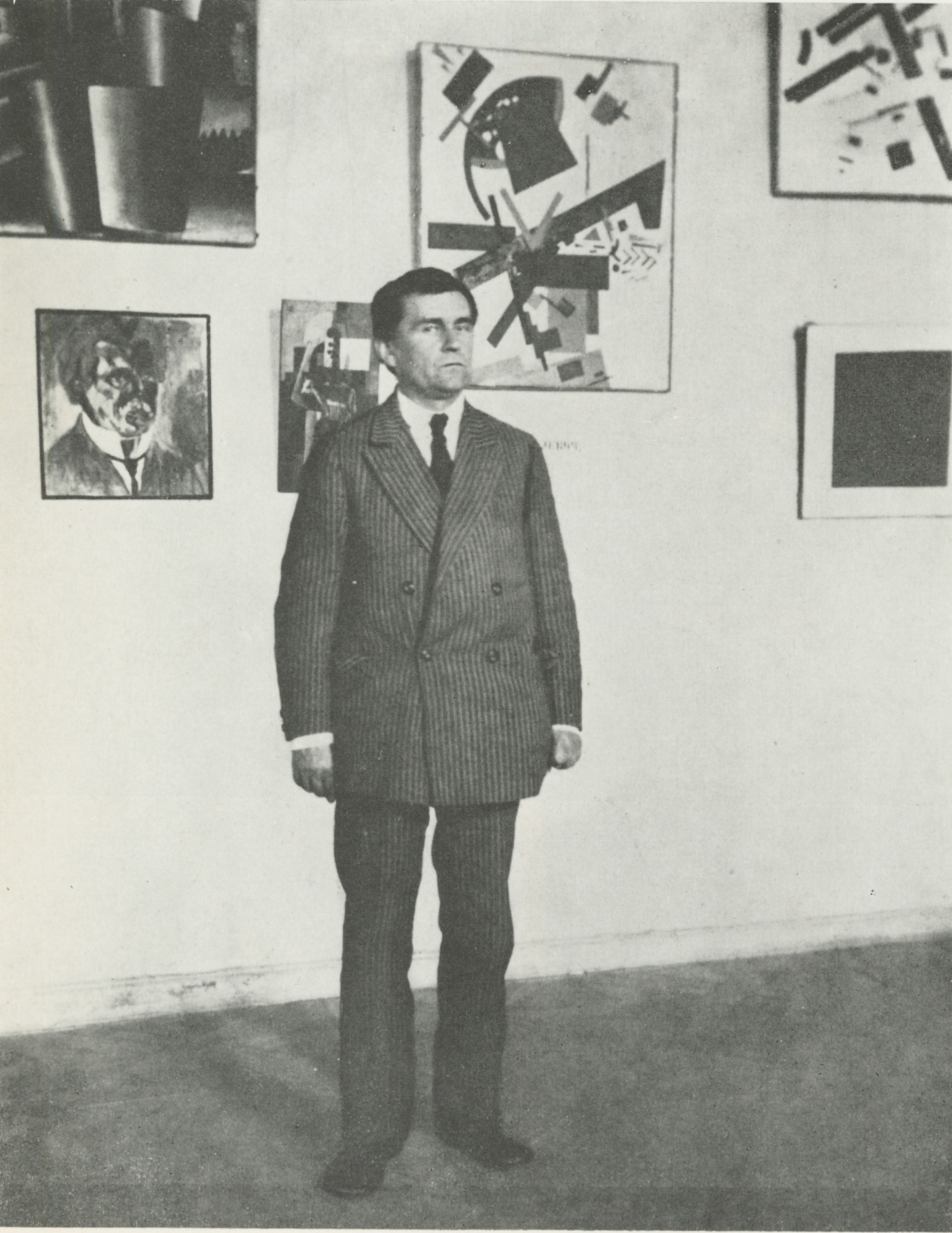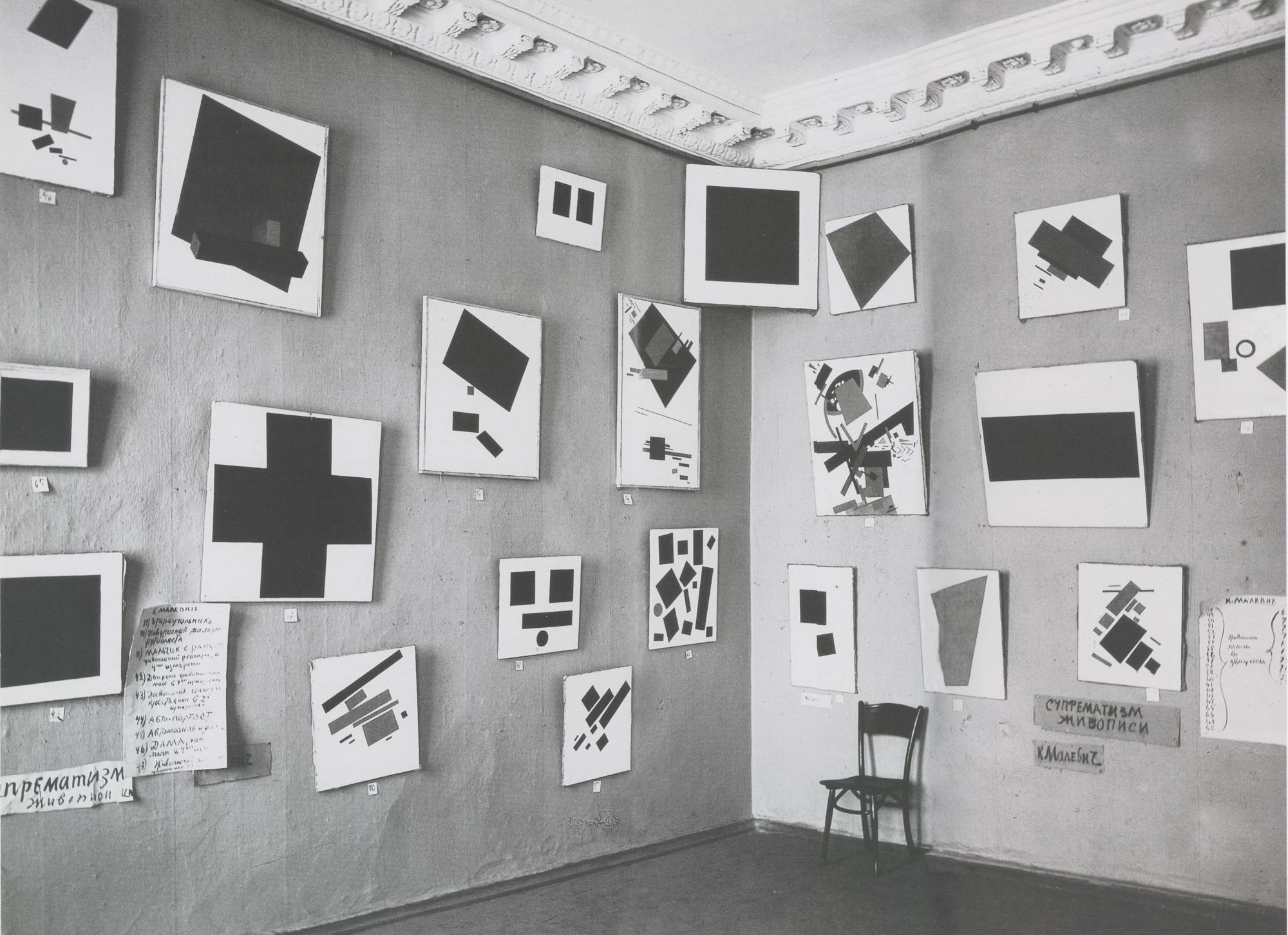|
Malevich
Kazimir Severinovich Malevich (Запись о рождении в метрической книге римско-католического костёла св. Александра в Киеве, 1879 год // ЦГИАК Украины, ф. 1268, оп. 1, д. 26, л. 13об—14. – 15 May 1935) was a |
Suprematism
Suprematism () is an early 20th-century art movement focused on the fundamentals of geometry (circles, squares, rectangles), painted in a limited range of colors. The term ''suprematism'' refers to an abstract art based upon "the supremacy of pure artistic feeling" rather than on the figurative depiction of real-life subjects. Founded by Russian artist Kazimir Malevich in 1913, Supremus () conceived of the artist as liberated from everything that predetermined the ideal structure of life and art. Projecting that vision onto Cubism, which Malevich admired for its ability to deconstruct art, and in the process change its reference points of art, he led a group of Russian avant-garde artists—including Aleksandra Ekster, Liubov Popova, Olga Rozanova, Ivan Kliun, Ivan Puni, Nadezhda Udaltsova, Nina Genke-Meller, Ksenia Boguslavskaya and others—in what has been described as the first attempt to independently found a Russian avant-garde movement, seceding from the trajecto ... [...More Info...] [...Related Items...] OR: [Wikipedia] [Google] [Baidu] |
Black Square (painting)
''Black Square'' () is a 1915 oil on linen canvas painting by the Russian avant-garde artist and theorist Kazimir Malevich. There are four painted versions, the first of which was completed in 1915 and described by the artist as his breakthrough work and the inception of his Suprematist art movement (1915–1919).Jakovljevic (2004), p. 19 In his manifesto for the Suprematist movement Malevich said the paintings were intended as "desperate struggle to free art from the ballast of the objective world" by focusing only on form.Blanshard (1949). p. 4 He sought to create paintings that all could understand and that would have an emotional impact comparable to religious works. The 1915 ''Black Square'' was the turning point in his career and defined the aesthetic he was to follow for the remainder of his career; his other significant paintings include variants such as '' White on White'' (1918), '' Black Circle'' (c. 1924), and '' Black Cross'' (c. 1920–23). Malevich painted three ... [...More Info...] [...Related Items...] OR: [Wikipedia] [Google] [Baidu] |
UNOVIS
UNOVIS (, also known as MOLPOSNOVIS and POSNOVIS) was a short-lived but influential group of artists, founded and led by Russian painter Kazimir Malevich at the Vitebsk Art School in 1919. Initially formed by students and known as MOLPOSNOVIS, the group formed to explore and develop new theories and concepts in art. Under the leadership of Malevich they renamed to UNOVIS, chiefly focusing on his ideas on Suprematism and producing a number of projects and publications whose influence on the avant-garde in Russia and abroad was immediate and far-reaching.Essay: ''Black Square: In the Circle of Malevich and UNOVIS Group'' The group disbanded in 1922. The name UNOVIS is an |
An Englishman In Moscow
''An Englishman in Moscow'' (, ), is a 1914 oil on canvas painting by Russian avant-garde artist and art theorist Kazimir Malevich. Description The titular Englishman depicted in the painting is wearing a top hat and an overcoat. The man's face is partially obscured by a white fish. Regarding the identity of the man painted by Malevich, the Head of Archives at the Stedelijk Museum, Michiel Nijhoff, has said, "The Englishman is not a specific Englishman but rather a metaphor in the juxtaposition of East and West; city and countryside." The painting itself features a collage of geometric shapes and items such as a lit candle, scimitar, a ladder, a wooden spoon and other items. Malevich also painted symbols and text characters onto the canvas—segments of the words "partial" and "solar eclipse" are seen in Russian. Malevich had been influenced by Russian literary futurists and the inclusion of Russian text, text fragments, and puns can be seen in at least two of his canvases ('' ... [...More Info...] [...Related Items...] OR: [Wikipedia] [Google] [Baidu] |
White On White
''Suprematist Composition: White on White'' (1918) is an abstract oil-on-canvas painting by Kazimir Malevich. It is one of the more well-known examples of the Russian Suprematism movement, painted the year after the October Revolution. Part of a series of "white on white" works begun by Malevich in 1916, the work depicts a white square, portrayed off-centre and at an angle on a ground which is also a white square of a slightly warmer tone. The work measures . Malevich dispenses with most of the characteristics of representational art, with no sense of colour, depth, or volume, leaving a simple monochrome geometrical shape, not precisely symmetrical, with imprecisely defined boundaries. Although the artwork is stripped of most detail, brush strokes are evident in this painting and the artist tried to make it look as if the tilted square is coming out of the canvas. Malevich intended the painting to evoke a feeling of floating, with the colour white symbolising infinity, an ... [...More Info...] [...Related Items...] OR: [Wikipedia] [Google] [Baidu] |
Modern Art
Modern art includes artistic work produced during the period extending roughly from the 1860s to the 1970s, and denotes the styles and philosophies of the art produced during that era. The term is usually associated with art in which the traditions of the past have been thrown aside in a spirit of experimentation. Modern artists experimented with new ways of seeing and with fresh ideas about the nature of materials and functions of art. A tendency away from the narrative, which was characteristic of the traditional arts, toward abstraction is characteristic of much modern art. More recent artistic production is often called contemporary art or Postmodern art. Modern art begins with the post-impressionist painters like Vincent van Gogh, Paul Cézanne, Paul Gauguin, Georges Seurat and Henri de Toulouse-Lautrec. These artists were essential to modern art's development. At the beginning of the 20th century Henri Matisse and several other young artists including the Proto-Cubism, pre ... [...More Info...] [...Related Items...] OR: [Wikipedia] [Google] [Baidu] |
Vladimir Tatlin
Vladimir Yevgrafovich Tatlin (; ; – 31 May 1953) was a Russian and Soviet painter, architect, and stage-designer. Tatlin achieved fame as the architect who designed The Monument to the Third International, more commonly known as Tatlin's Tower, which he began in 1919. Honour, H. and Fleming, J. (2009) ''A World History of Art''. 7th edn. London: Laurence King Publishing, p. 819. With Kazimir Malevich he was one of the two most important figures in the Soviet avant-garde art movement of the 1920s, and he later became an important artist in the constructivist movement. Biography Vladimir Yevgrafovich Tatlin was born in Moscow or Kharkov, Russian Empire. His father, Yevgraf Nikoforovich Tatlin was a hereditary nobleman from Oryol, a mechanical engineer graduated from the Technological Institute in St.Petersburg and employed by the Moscow-Brest Railway in Moscow. His mother, Nadezhda Nikolaevna Tatlina (Bart) was a poet who sympathized with the Narodnaya Volya revolutionary ... [...More Info...] [...Related Items...] OR: [Wikipedia] [Google] [Baidu] |
Abstract Art
Abstract art uses visual language of shape, form, color and line to create a Composition (visual arts), composition which may exist with a degree of independence from visual references in the world. ''Abstract art'', ''non-figurative art'', ''non-objective art'', and ''non-representational art'' are all closely related terms. They have similar, but perhaps not identical, meanings. Western art had been, from the Renaissance up to the middle of the 19th century, underpinned by the logic of Perspective (graphical), perspective and an attempt to reproduce an illusion of visible reality. By the end of the 19th century many artists felt a need to create a new kind of art which would encompass the fundamental changes taking place in technology, science and philosophy. The sources from which individual artists drew their theoretical arguments were diverse, and reflected the social and intellectual preoccupations in all areas of Western culture at that time. Abstraction indicates a departu ... [...More Info...] [...Related Items...] OR: [Wikipedia] [Google] [Baidu] |
Alexander Bogomazov
Alexander Konstantinovich Bogomazov () or Oleksandr Kostiantynovych Bohomazov (; March 26, 1880 – June 3, 1930) was a Ukrainians, Ukrainian Painting, painter, cubo-futurist, modern art theory, theoretician and is recognised as one of the key figures of the Ukrainian avant-garde scene. In 1914, Oleksandr wrote his treatise ''The Art of Painting and the Elements''. In it he analyzed the interaction between Object, Artist, Picture, and Spectator and sets the theoretical foundation of modern art. During his artistic life Oleksandr Bohomazov mastered several art styles. The most known are Cubo-Futurism (1913–1917) and Spectralism (1920–1930). Early life Oleksandr Bohomazov was born in Yampil, Sumy Oblast, Yampil, Kharkiv Region (now Sumy Oblast, Ukraine) as a second child to Kostiantyn & Anisia Bohomazov's. The artist's father was an accountant, who worked at the local sugar factory and later rose to the status of a merchant. The boy hardly knew his mother – she left the fami ... [...More Info...] [...Related Items...] OR: [Wikipedia] [Google] [Baidu] |
Ukrainian Avant-garde
Ukrainian avant-garde is the avant-garde movement in Ukrainian art from the end of 1890s to the middle of the 1930s along with associated artists in sculpture, painting, literature, cinema, theater, stage design, graphics, music, and architecture. Some well-known Ukrainian avant-garde artists include: Kazimir Malevich, Alexander Archipenko, Vladimir Tatlin, Sonia Delaunay, Vasyl Yermylov, Alexander Bogomazov, Aleksandra Ekster, David Burliuk, Vadym Meller, and Anatol Petrytsky. All were closely connected to the Ukrainian cities of Kyiv, Kharkiv, Lviv, and Odesa by either birth, education, language, national traditions or identity. Since it originated when Ukraine was part of the Russian Empire, Ukrainian avant-garde has been commonly lumped by critics into the Russian avant-garde movement. The first formal Ukrainian artistic group to call itself "Avangarde" (Avant-garde) was founded in Kharkiv in 1925. The term, "Ukrainian Avant-Garde", concerning painting and sculpture during S ... [...More Info...] [...Related Items...] OR: [Wikipedia] [Google] [Baidu] |
Russian Avant-garde
The Russian avant-garde was a large, influential wave of avant-garde modern art that flourished in the Russian Empire and the Soviet Union, approximately from 1890 to 1930—although some have placed its beginning as early as 1850 and its end as late as 1960. The term covers many separate, but inextricably related, art movements that flourished at the time; including Suprematism, Constructivism (art), Constructivism, Russian Futurism, Cubo-Futurism, Zaum, Imaginism, and Neo-primitivism. In Ukraine, many of the artists who were born, grew up or were active in what is now Belarus and Ukraine (including Kazimir Malevich, Aleksandra Ekster, Vladimir Tatlin, David Burliuk, Alexander Archipenko), are also classified in the Ukrainian avant-garde. The Russian avant-garde reached its creative and popular height in the period between the Russian Revolution of 1917 and 1932, at which point the ideas of the avant-garde clashed with the newly emerged state-sponsored direction of Socialis ... [...More Info...] [...Related Items...] OR: [Wikipedia] [Google] [Baidu] |
Geometric Abstraction
Geometric abstraction is a form of abstract art based on the use of geometric forms sometimes, though not always, placed in non-illusionistic space and combined into non-objective (non-representational) compositions. Although the genre was popularized by avant-garde artists in the early twentieth century, similar motifs have been used in art since ancient times. History Geometric abstraction is present among many cultures throughout history both as decorative motifs and as art pieces themselves. Islamic art, in its prohibition of depicting religious figures, is a prime example of this geometric pattern-based art, which existed centuries before the movement in Europe and in many ways influenced this Western school. Aligned with and often used in the architecture of Islamic civilations spanning the 7th century-20th century, geometric patterns were used to visually connect spirituality with science and art, both of which were key to Islamic thought of the time. Scholarly analysis ... [...More Info...] [...Related Items...] OR: [Wikipedia] [Google] [Baidu] |





